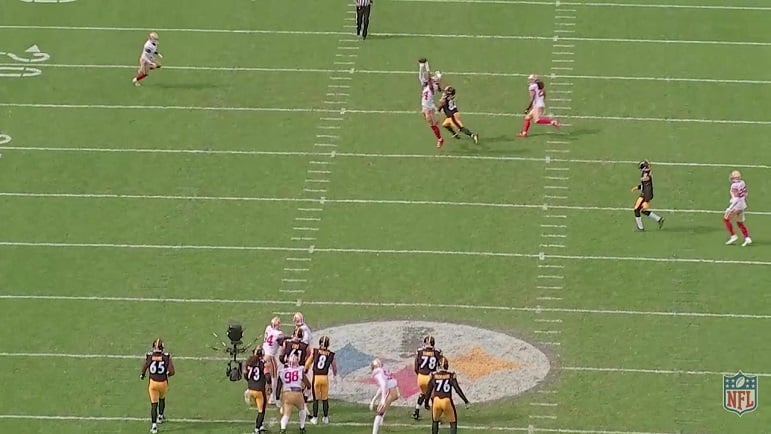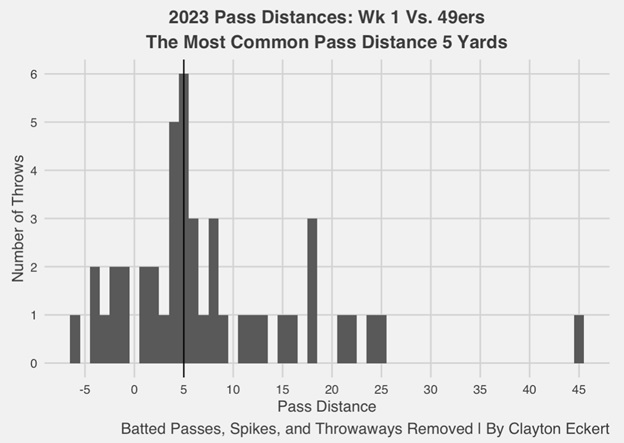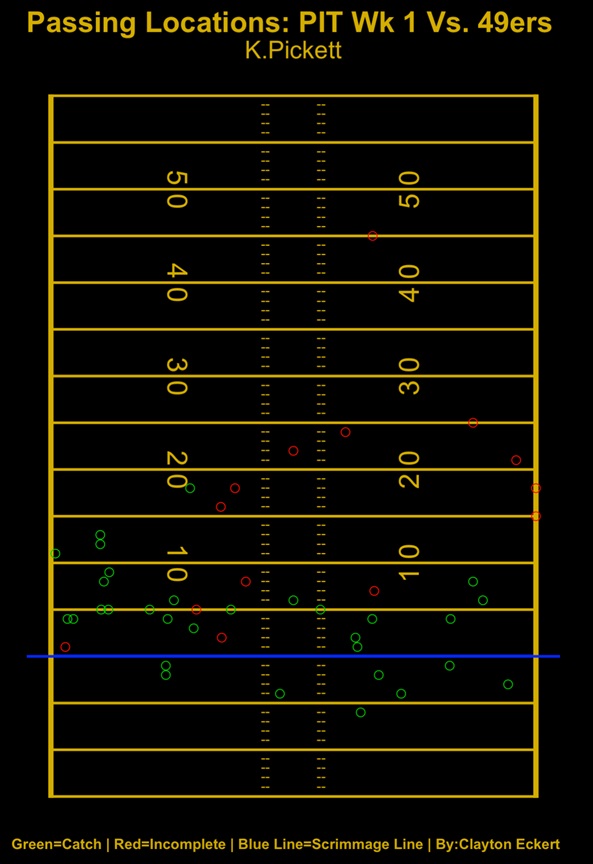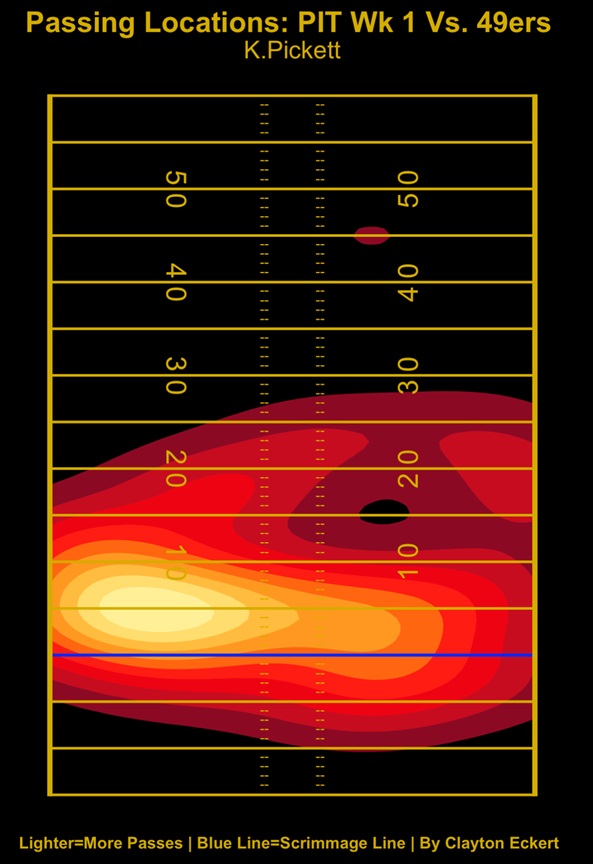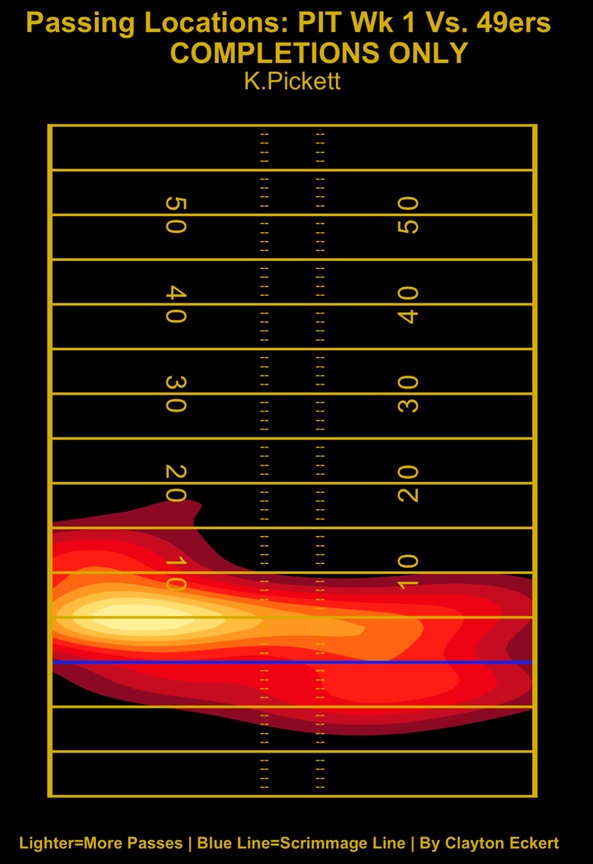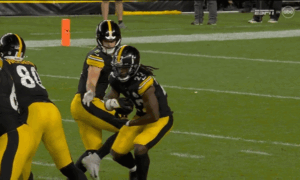With week one now in the books, it’s time to begin my quarterback charting of the regular season. In case you missed the previous preseason and 2022 I will be charting, visualizing, and providing takeaways for the all-important quarterback position for the Pittsburgh Steelers.
Couple of notes before we jump in. Thanks to Thomas Mock for his great work that helped me learn much of what I’m using in the series visually. Spikes and clear throwaways are removed due to being the correct situational decision, along with batted passes at the line of scrimmage. One removed pass this week, a spike.
After a stellar preseason, the regular season home opener was downright painful. Particularly a horrid start, with five straight three and outs and 18 passing yards (-3 air yards), then finally getting a first down just before halftime (a 24-yard explosive Najee Harris run). On the stat sheet, quarterback Kenny Pickett went 31-of-46 (67.4 percent) for 232 yards, one touchdown, two interceptions, a 68.4 passer rating, and five sacks, yuck. His 125 completed air yards (53.9 percent) on the game seem decent in totality, but had just 36 in the first half despite getting down on the scoreboard early. Poor decision making, unusual accuracy issues, and communication problems with receivers were unfortunately the name of the game to open the 2023 season on a 30-7 loss.
Let’s start with a simple view of the 45 charted passes, with number of throws at each pass distance for Week One:
The chart highlights far less downfield passing than you’d expect given the scoreboard, frustratingly. Instead, it looks like a typical chart to a close game, or even being ahead, which we all know was far from the truth.
The most common pass distance, as it is for the vast majority of games, was 0-5 air yards at 35.6 percent. The first play of the game was a successful throw to wide receiver George Pickens at five air yards. On the fourth drive, Pickett was hit on the throw (allowed by left tackle Dan Moore), a near pick at five air yards well behind wide receiver Allen Robinson. Another was a wheel route to running back Anthony McFarland Jr. out of the backfield, the first chain-moving pass on fourth and three in the red zone before halftime. This was big in setting up Pittsburgh’s lone touchdown, a nice zip throw and catch by tight end Pat Freiermuth on an out route at the front of the end zone.
In the third quarter, Pickett opened with a short pass to wide receiver Diontae Johnson at four air yards, making a great cut to get outside the defender for explosive YAC and a 26-yard gain. Unfortunately, Johnson injured his hamstring on the play, and reports are he will miss at least a couple of weeks. This is obviously huge a huge void to fill, with wide receiver Calvin Austin III likely the primary candidate. He caught the following pass at this distance on an out route, a nice throw with the pocket collapsing. On third and four in the same drive, Pickett was off target, throwing way behind Robinson.
In total, 31.1 percent of passes were 5-10 air yards. On third and six in the second quarter, Pickett was off target again, this one to Freiermuth at seven air yards, which was the fifth third down fail in a row to start the game. Late in the first half, Pickett threw a bit behind Johnson on a slant in the red zone, seemingly would have been a touchdown if it was on the money. In the third quarter, tight end Connor Heyward made a nice catch outside of his frame for eight yards.
Behind the line passes were way higher than expected given the game script, at 17.8 percent. For context, that rate was 9.5 percent in the preseason, and 13.6 percent in the 2022 regular season. The second play of the game was a flip pass to Austin, where Freiermuth failed to block anyone, frankly looking lost on the loss of one. Pittsburgh was intent on getting Austin involved in the short game early, getting the screen pass to him on the following play with nice YAC on the seven-yard gain. Half of these plays came in the second half, all to running backs. The most frustrating was a passive play call, a third and four fail late in the third quarter that felt like the last hurrah for any comeback attempt. Ugh.
In total, 11.1 percent of passes were 15-20 air yards. The first was a bit behind Freiermuth towards the end zone, who got absolutely drilled by the defender jarring the ball loose for the incompletion. That’s another player to monitor from a health perspective. Knock on wood he can play, especially considering Johnson’s injury. On a third and six, Pickett was antsy and overthrew Robinson on the move. Another went incomplete to Pickens on an end zone target, making a nice snag but was unfortunately out of bounds. The most frustrating was the previously mentioned “last hurrah” drive, another poor play call on fourth and four with four vertical routes in the red zone, and the pass/communication are way off the mark on the fail. One was a nice catch and run by Robinson, with YAC for an explosive 31 yard gain, but came with three minutes left and the loss already etched.
Explosive attempts were a confusingly low 11.1 percent, compared to 16.2 percent in the preseason and 13.9 percent in 2022. Quality was dreadful as well, with all five attempts incompletions, including Pickett’s two interceptions. The first was a bad throw/decision to on the second drive to Johnson, who slipped on the play as well. The other was another poor decision in the fourth quarter, forcing the throw to Heyward in double coverage. On the third drive, Pickett was off target again on a post to Johnson, with both of these coming over the middle. The longest pass distance was 45 air yards, thinking he had a free play (debatable offsides), overthrowing Pickens on the go route against good coverage. The last was an end zone target to Heyward, once again overthrown.
The least common pass distance was 10-15 air yards (8.9 percent). Some nice plays here, one against a blitz and getting it to Johnson before the half. Another was early in the fourth quarter, a nice throw and route outside the numbers to Austin. A few plays later was along the sideline to Heyward, who went down and made a great catch.
Here are the dots of completions and incompletions for week one:
A few unfortunate things jump out right away. Pickett went 0-for-5 on explosive air yards with two interceptions, and had only one completion past of 15-plus air yards late in the game. Excruciating in a blowout loss, especially. The middle of the field was a struggle as well, going a painful 2-for-9 (22.2 percent) between the numbers past five air yards, wow. Also ineffective to the right outside the numbers, going 0-for-4 at 15-plus air yards, and no such attempts to the left. In totality, 17-for-22 outside the numbers (77.3 percent) with the longest 13 air yards, and 14-of-22 on/inside the numbers (63.6 percent). Close to an even split in frequency, with 51.1 percent of passes on or between the numbers.
Now for completion rates by distances:
Behind the line: 8/8 (100 percent)
0-5 air yards: 13/16 (81.3 percent)
5-10 air yards: 11/14 (78.6 percent)
10-15 air yards: 3/3 (100 percent)
15-20 air yards: 1/5 (20 percent)
Explosive: 0/5 (0 percent)
To close, here are the heat maps for all pass attempts, along with the completions only heat map (brace yourselves):
Not what you want to see from your second-year quarterback who had us feeling so optimistic to start the 2023 season. The first thing I’d like to see in week two is for Pittsburgh to establish the run unlike the opener, which will hopefully aid the passing game. Particularly for Pickett, starting the game strong, accuracy, decision making, communication with receivers, 15-plus air yards, and the middle of the field are what I’ll be monitoring most against the Browns on Monday night.
Thanks for reading and let me know your thoughts in the comments.

